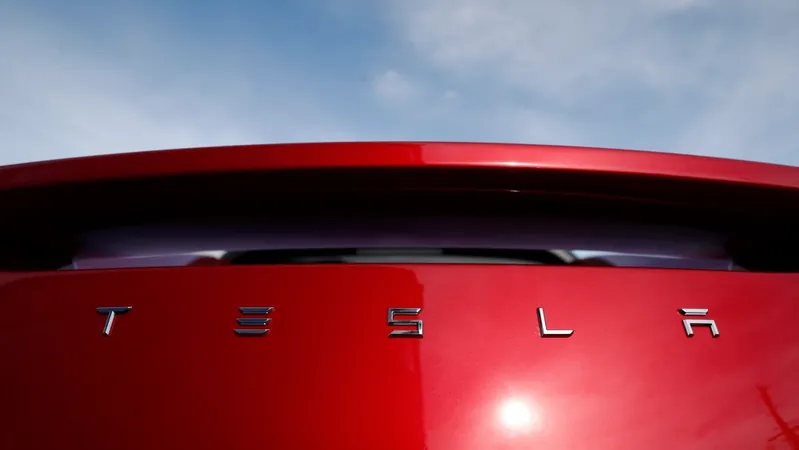
Trapped in a Tesla? Shocking Realities of Emergency Access Challenges After Multiple Fatal Crashes!
2024-11-13
Author: Olivia
Tragic Incidents Highlight Safety Concerns
In recent weeks, tragic incidents involving Tesla vehicles have raised serious concerns regarding the accessibility of emergency latches and overall safety in dire situations. A haunting crash on Lakeshore Blvd. in Toronto last month left the local community in mourning as first responders struggled to rescue trapped occupants.
Witness Rick Harper described the scene: "You couldn’t open the car." Despite seeing flames engulfing the vehicle, officials and bystanders faced the nightmarish reality that without power, Tesla doors remained locked. After numerous attempts, they resorted to breaking a window to save a woman, though tragically, four others—including the driver—lost their lives inside.
The investigation into the fatal crash is ongoing, as authorities attempt to piece together whether the fire or the crash directly led to the fatalities. What has emerged, however, is a growing concern regarding the safety protocols surrounding electric vehicles (EVs) in emergencies. With Teslas and other EVs reliant on battery power for door operation, any failure could result in deadly consequences.
More Fatalities: The Dangers of Electric Vehicles
Just days later, another devastating incident occurred in Wisconsin, where five people lost their lives when a Tesla collided with a tree and was consumed by flames. The recurrence of these tragic events has prompted experts to rethink the protocols for first responders handling electric vehicle emergencies.
Mike Klimkosky, a safety consultant, shared his insights on the unique challenges posed by electric vehicles. He emphasized the presence of manual emergency latches inside Teslas, which can provide a vital means of escape. Located typically on the driver’s side and sometimes in the back seat, these latches could be lifesaving if recognized and accessed in time. Klimkosky stressed that every Tesla owner should familiarize themselves with their vehicle's manual to ensure they are equipped with this critical knowledge.
Incidents of Inaccessibility & Legal Ramifications
However, this knowledge may be insufficient if individuals are incapacitated, disoriented, or if conditions like submersion or extreme fire impede access to these latches. Another Toronto resident, Edris Kyalignmba, recounted a harrowing experience in July when rising floodwaters trapped him inside his Tesla. "The windows were stuck, the doors were stuck. I couldn't open the car. It was really scary," he recalled, likening the experience to a horror movie.
The implications are severe—not just for the individuals involved but for manufacturers as well. In a separate case, a Florida family filed a lawsuit against Tesla after their loved one, Omar Awan, died in a 2019 incident. The family claims that the car's design prevented first responders from accessing Awan during a fire, despite the medical examiner's report stating that he died from burns and toxic fumes rather than from the initial crash.
Manufacturers' Responses and Safety Assurances
Tesla has firmly denied the family's claims, asserting that its vehicles meet industry safety standards. Nevertheless, Klimkosky reassured the public that electric vehicles, including Teslas, are safe and potentially safer than their gas-powered counterparts, citing studies that show over a 40% reduction in injury claims for electric vehicle occupants compared to identical gas models.
Towards a Safer Future for EVs
The increase in electric vehicle ownership necessitates a dialogue about preparedness and education regarding emergency procedures. As these vehicles become more prevalent on our roads, ensuring that both owners and first responders are adequately prepared to handle emergencies could mean the difference between life and death.
Stay informed, stay safe, and make sure to check your vehicle's manual—the latch that could save your life may just be a pull away!









 Brasil (PT)
Brasil (PT)
 Canada (EN)
Canada (EN)
 Chile (ES)
Chile (ES)
 España (ES)
España (ES)
 France (FR)
France (FR)
 Hong Kong (EN)
Hong Kong (EN)
 Italia (IT)
Italia (IT)
 日本 (JA)
日本 (JA)
 Magyarország (HU)
Magyarország (HU)
 Norge (NO)
Norge (NO)
 Polska (PL)
Polska (PL)
 Schweiz (DE)
Schweiz (DE)
 Singapore (EN)
Singapore (EN)
 Sverige (SV)
Sverige (SV)
 Suomi (FI)
Suomi (FI)
 Türkiye (TR)
Türkiye (TR)